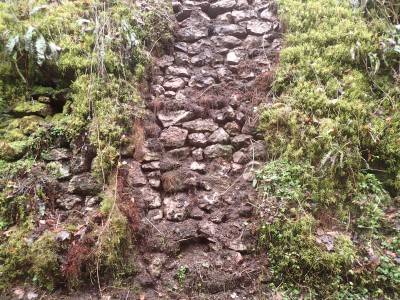16th April 2017: with Nick Hawkes, Paul Brock and Duncan Price.
This trip had a plan, to go and tickle the choke at the end of the sandy passage in Home Close Hole. I took the capping gear, just in case, but it was not required in the end, Brockers rigged the pitch and led the way, which was curious, as he has always expressed a dislike of pushing chokes.
We followed the inlet stream to where it issues from the boulder choke, then climbed the loose muddy slope to a point where further upward progress was not possible. A small gap was expanded and access to a small chamber was possible. It measured c.5m (l) x 2m (w) x 2m (h) was full of loose boulders and formed along a mineral vein, the floor wasn’t too stable either. After a quick look around, Nick and Vince took it in turns to remove cobbles and boulders from an enticing looking space upwards. Nick managed to cause a slump of boulders that left things teetering on the brink. Nothing moved. We needed a rope, so all our belts were tied together and Vince got a loop over the chock-stone and pulled. That worked. A bit of gardening, Vince then accessed c. 7m (l) of horribly loose ascending passage that closed down to a very narrow fissure, there isn’t a way on here. Here, many of the rocks have a black manganese coating, and there is a trickle of water.
Meanwhile, Duncan had spotted another gap leading downwards and needed assistance to open it up further. Eventually we abandoned this, made our way back down the slope, looked at some potential options off the slope, but after some discussion we decided the best plan was to dig at stream level where there is, at least one solid wall.
We went downstream a little way and climbed up another slope into the choke. Here, there is an open space beyond a precariously balanced boulder that would require moving if further progress was to be made. Gingerly, Vince used a small bar to ease the boulder out of the way, luckily, nothing more came with it. A short clamber up gained access to a gnarly, sharp, boulder passage, a couple of squeezes, it closed down after about 15m. There were some gaps overhead but, as a digging prospect it looked pretty hopeless. Duncan had noticed another space overhead, estimated c.3m (l) but this was not entered.
By now, it seemed everyone had had enough of playing ‘ker-plunk’ and Brockers was already on his way back to the pitch. Although Vince was last up the pitch, Duncan had waited and de-rigged. On the surface were Tony, Chris, Alice and Caroline, after changing, tea and sausage rolls was welcomed, followed by a de-brief about todays events. Then, we all headed off to a very busy Queen Vic for more refreshment.















